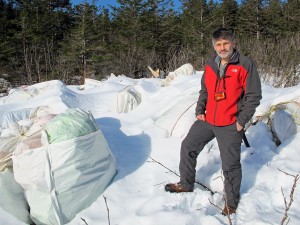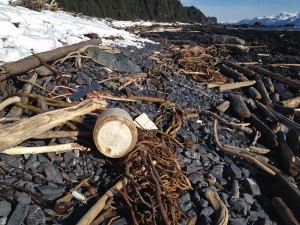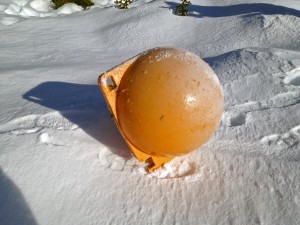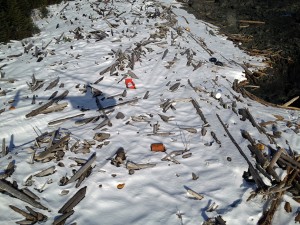The state is planning an aerial survey this spring to figure out how much new debris from the 2011 Japanese tsunami has arrived on Alaska’s shores. Environmental groups spent much of last summer cleaning up debris. But the state’s vast and rugged coastline has made it a slow and costly project. APRN’s Annie Feidt visited Montague Island, on the edge of Prince William Sound with the man who’s leading the effort to return Alaska’s hardest hit beaches to their pristine state.

Chris Pallister steps out of the helicopter, on to the snow covered inner shore of Montague Island.
It’s a brilliant sunny day in early March and Pallister, who is President of Gulf of Alaska Keeper, is visiting Montague to get a handle on how much new debris washed up on the Island over the winter. He also needs to check on debris his crew collected into heavy duty bags called super sacks last summer. Pallister wants to make sure they held up over the punishing winter months:
“I guess it’s alright. I don’t see any damage here or anything.”
Related: Tsunami Debris Problem Gets Worse in Alaska, with Little Clean Up Funding In Sight
He rummages through a bag perched on the edge of a huge mound of super sacks. The bag is open on top, but otherwise looks ok:
Feidt: “Describe what’s in the bag.”
Pallister: “So anywhere from tiny little pieces of Styrofoam, all the way up to buoys and ropes and nets. But a tremendous amount of urethane foam, polystyrene foam and just plain Styrofoam.”
Pallister measures debris not by the pound, but by the ton. And on outer Montague Island, he estimates there is 20 to 30 tons of debris per mile. He guesses about half of it (by volume) is from the tsunami and half is the usual marine trash that has been washing up in increasing amounts for decades. Last summer, he used funding from the legislature and other sources to begin cleaning the first three miles of the island’s coast.

“There’s another almost 70 miles to do on this shoreline and we spent close to 60 days cleaning these few miles that we did here, so this is a huge, huge problem. This island is really bad.”
The state identified Montague as one of nine priority areas for tsunami debris clean up. There are other hotspots from the southern tip of Southeast to as far west as the islands off of Kodiak. Japan gave the United States five million dollars for cleaning up debris in all the west coast states. So far, Alaska has received the biggest chunk of that money, $1 million. Elaine Busse Floyd is a director at the Department of Environmental Conservation. She thinks the state will be able to make the case for additional funding than other coastal states:
“Oregon has somewhere around 300 miles of coastline and we would call that a day trip. And they were able to put dumpsters and have volunteers go out and they just had to empty a few dumpsters a little more often. And that’s completely not the situation Alaska is faced with.”

Alaska’s situation is vast coastline, often inaccessible even to small landing craft, combined with huge quantities of debris. Floyd is working on a federal grant application for more funding that would pay for a barge to pick up the super sacks Pallister and other groups are collecting. A helicopter would lift the sacks onto the barge and then the trash would go a recycling center in Seattle or landfill in Oregon.
Pallister is hopeful that funding will come through. He says it will cost millions more just to clean Montague:
“There’s actually a lot of new stuff here.”
He points out debris as he walks along the shale rock shore, next to the surf:

“That’s an Asian bottle. Japanese. Look at all this plastic. This was all just cleaned in September.”
Montague Island is a spectacular stretch of Alaska shoreline. Pallister says the island has some of richest habitat in Prince William Sound. It’s is home to Sea Lions, Brown Bears and has a strong silver salmon run. It’s popular with local hunters, but few other people visit. Pallister is determined to clean it anyway:
“People always ask me, why do you do this? And I just tell them, you clean your kitchen counters. This is where we get our sustenance in this state. The inter-tidal area is where a lot of our fishing resources and all that came from. So I say this is our kitchen counter and a rational person keeps their kitchen counters clean.”
On his way back to the helicopter, Pallister compulsively picks up bottles and other small items and flings them above the tide line. He and his crew will be back to put them in super sacks later this summer.
Annie Feidt is the broadcast managing editor at Alaska Public Media. Reach her atafeidt@alaskapublic.org. Read more about Anniehere.





